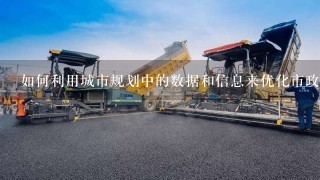如何利用城市规划中的数据和信息来优化市政工程施工方案?

City Data and Information for Urban Engineering Optimization
1. Traffic Data:
- Traffic volume and patterns
- Travel times and congestion
- Public transport usage
- Road closures and accidents
2. Land Use Data:
- Land use zoning
- Building density
- Commercial and residential areas
- Green spaces and infrastructure
3. Infrastructure Data:
- Water and sewer systems
- Transportation infrastructure (roads, bridges, subway)
- Energy infrastructure
- Telecommunication networks
4. Population Data:
- Demographics (age, income, education)
- Housing patterns
- Community amenities and services
5. Economic Data:
- Business activity
- Employment centers
- Tourism and recreation
- Property values
6. Environmental Data:
- Air quality
- Water quality
- Climate patterns
- Green spaces and biodiversity
7. Social Data:
- Public opinion
- Community engagement
- Safety and security
- Social services
8. Spatial Data:
- Satellite imagery
- GIS maps
- Street maps
Optimization Techniques:
1. Simulation Modeling:
- Traffic simulation software to predict traffic patterns and congestion.
- Infrastructure simulation software to assess the impact of changes on infrastructure capacity.
- Environmental impact simulation software to evaluate the effects on air quality and water quality.
2. Data Analytics:
- Statistical analysis to identify patterns and trends.
- Machine learning algorithms to predict and optimize outcomes.
3. Decision Support Tools:
- GIS platforms to visualize data and support decision-making.
- Interactive dashboards to provide real-time insights.
4. Stakeholder Engagement:
- Involve stakeholders in data collection, analysis, and decision-making.
- Conduct public surveys and focus groups to gather feedback.
5. Iterative Optimization:
- Regularly review and adjust plans based on data-driven insights.
- Implement changes to infrastructure, transportation, and other systems.
Benefits of Data-Driven City Planning:
- Improved traffic flow and reduced congestion.
- Enhanced public safety and security.
- Reduced environmental impact.
- Increased economic development.
- Improved quality of life for residents.





































































